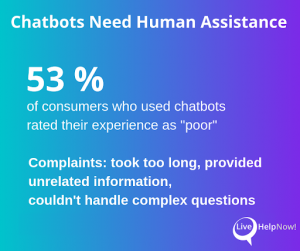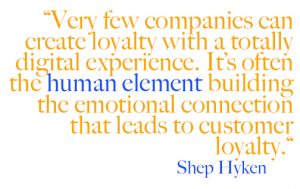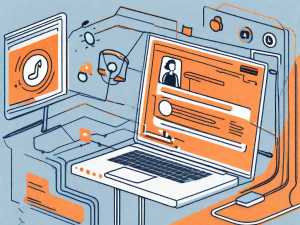“Are you a real human?”
We get this question all the time when we start our virtual chat sessions here at LiveHelpNow.
Our customers don’t want to talk to robots. They want human customer service, even if it’s over a web chat and about something a chatbot could solve easily.
What do Customers Want From Customer Service?
According to one recent survey, 70 percent of consumers said they would rather speak to a real human being rather than a robot. Even if it meant waiting.
In a world full of technology we value human interactions. Even more now than in the past, we crave human connection. A human touch has become scarce and lost its quality as computers, robots, and digital communications take over.
Which brings us to chatbots.
According to a customer service expectation survey conducted by customer service platform Gladly customers generally are dissatisfied with chatbot experience.
When it comes to customer service, personal service is everything; customers value it more.
Ok so the #DriveTest automated service made me want to throw the phone but the living person was AWESOME! 3 cheers for #humancustomerservice
— Jacqui EmpsonLaporte (@notrunningfast) May 22, 2012
Where do Chatbots Stand in Customer Service?
As we discussed in our previous blog post, robots will not take our jobs, though they might change the way we work and the kind of work we do.
When it comes to customer service, however, chatbots do one thing humans cannot – they cut costs. According to one prediction, chatbots can save as much as $8 billion by 2022 for businesses worldwide.
Related Post: Automated Live Chat Agents Are Going To Take Our Jobs. Or Aren’t They?
How?

As one researcher outlines it, cost servings come in various categories such as operational costs, lower labor expenses, around the clock availability, and efficiency.
With such significant cost savings, the idea of replacing real humans with chatbots in the customer service department is a rational one.
However, such a move might significantly lower the customer satisfaction rates and result in loss of business.
According to customer service expert Shep Hyken, “very few companies can create loyalty with a totally digital experience. It’s often the human element building the emotional connection that leads to customer loyalty.”
Hyken adds that about a third of customers will stop doing business after one negative interaction.
That means that if a chatbot misunderstands the tone of a customer’s inquiry or fails in communication where a human would not, the company will lose that costumer’s business.
In his Forbes’ article Hyken explains that quality customer experience is what ensures company loyalty. The speed of problem resolution is important.
But if customers experience an emotional connection with an agent and feel like they are dealing with fellow humans and not machines, they will remember the interaction in a positive light and will continue to patronize the business.
Gladly’s report confirms these findings: consumers choose service that is personalized over service that is fast.
How to Find Balance in Customer Service?
So, how does a company ensure customer satisfaction without significant cost increases?
They can do it by balancing their customer service responsibilities between cost saving, efficiently programmed chatbots and well-trained, personable human agents.
To achieve this balance, a company can implement chatbot services to complete common, repetitive tasks without heavily relying on them for complex customer service solutions.
Meanwhile, improving human customer service practices can help make the customer experience more personal, and therefore, more satisfactory.
Here are some tips that will help you do just that:
1. Stay positive throughout the conversation
Staying positive throughout communications with the customers reinforces professionalism, lightens the mood, and deflects any negative feelings.
If the customer service representative is genuinely positive, his or her attitude will transfer to the customer as well.

As Alina Tugend explains, humans remember positive and negative experiences differently. Because of the negativity bias our brains have, we tend to remember negative experiences more vividly and for longer periods of time.
To overcome this trait we must have five positive experiences to overcome one negative, Tugend argues.
When it comes to customer service we must create a positive experience for clients in order for them to be satisfied and remember the interaction in a good light.
There are some quick ways to adjust attitude:
- Smile – a conscious effort to smile instantly lifts one’s spirits; even if you’re not communicating with a customer face-to-face, the way you feel will be apparent to the client.
- Practice Mindfulness – feel your body breathing in and out. Count ten breaths, or five, or three, however much time you have. Doing this, especially in the moments of high stress, can help calm you down, ground, and refocus you.
- Move – take breaks often and at least once an hour. Sitting still for long can bring you down. Get up and move
Related Post: 20 Ways to Make Chat Experience More Personal
2. Actively listen to the customer’s concern
Being a good listener is essential for successful and productive communication.
John Chancellor of Paired Life explains that when people are being heard through the act of active listening “they feel like they are being heard and understood, and the undivided attention makes them feel valued and respected.”
If a customer is valued and respected, he or she will feel satisfied with the service.
Here are some tips on how to engage in active listening:
- Be patient
In the scheme of things, there is a temptation to rush the conversation. Remain calm and patient to ensure all due diligence.
- Ask follow up questions.
If something is unclear, do not be afraid to ask more questions to clarify. Confirming that you understood the issue correctly goes a long way and can eliminate misunderstandings.
- Empathy is essential.
Making the customer feel that you are listening and understanding will go a long way, especially if the customer is upset. Using words and phrases that stress empathy can help put through the message that you care about the customer sincerely.
3. Personalize the customer experience
As discussed above when a customer feels he or she is dealing with a human and not a machine the overall experience becomes more satisfying. The way to achieve this is by personalizing everything about the interactions.
Customer Service blogger Len Markidan offers some great points on how to make customer service more personal.

- Know the background of each customer’s history with the company. Look back through the customer’s previous interactions. Not having to repeat themselves when it comes to their issues makes customers feel special, heard, and important.
- Use the customer’s name as well as your own during interactions. Nothing says personal service as being addressed by your name and speaking to someone whose name you know.
- Show your face. You might not be interacting face-to-face, but you can still show that you’re a real human. Use an avatar picture for your emails or adding it to your live chat interface. Seeing the human face is proven to put people more at ease and smoother interactions.
Conclusion
While chatbots and automated customer service systems save companies money, they do not have the ability to provide what customers crave – human connections, personal experience, and the feeling of being important and special.
Implementing simple strategies such as positivity, sharp listening skills, and personalization can help improve these experiences without blowing up your customer service and support budget




